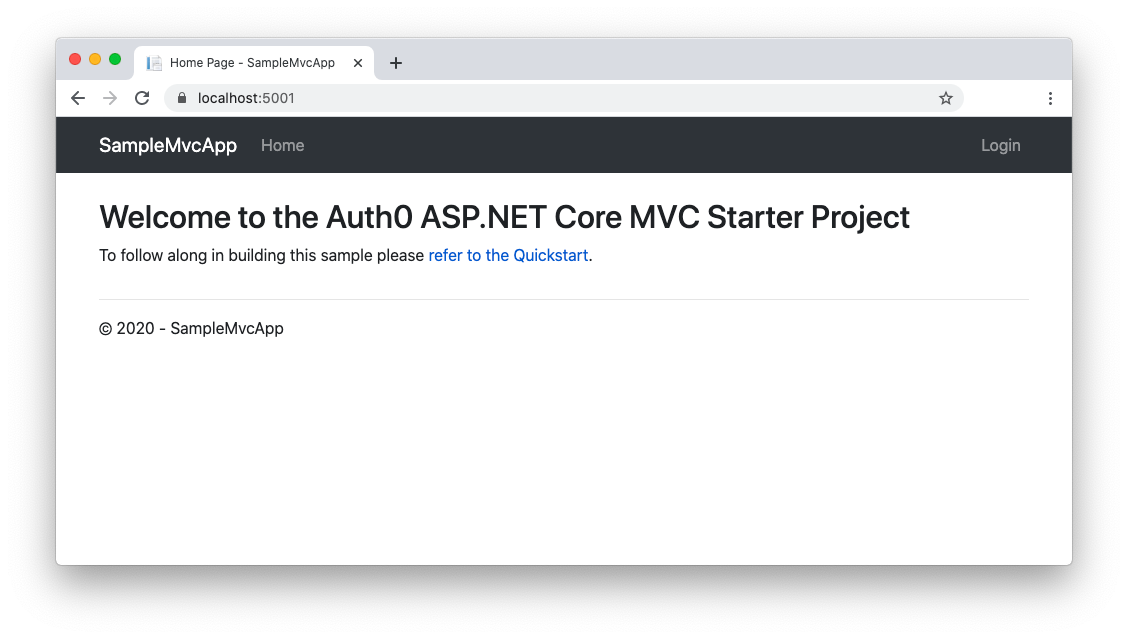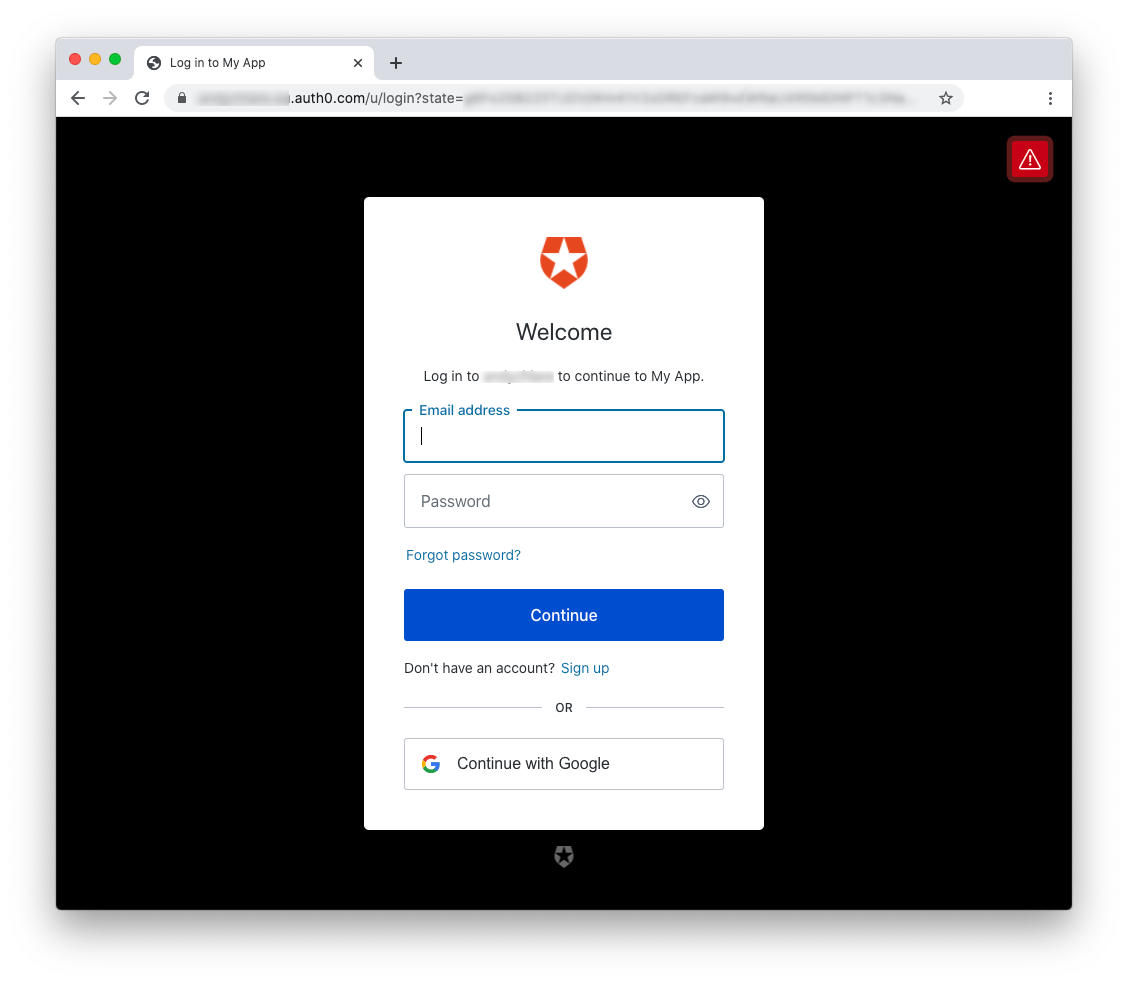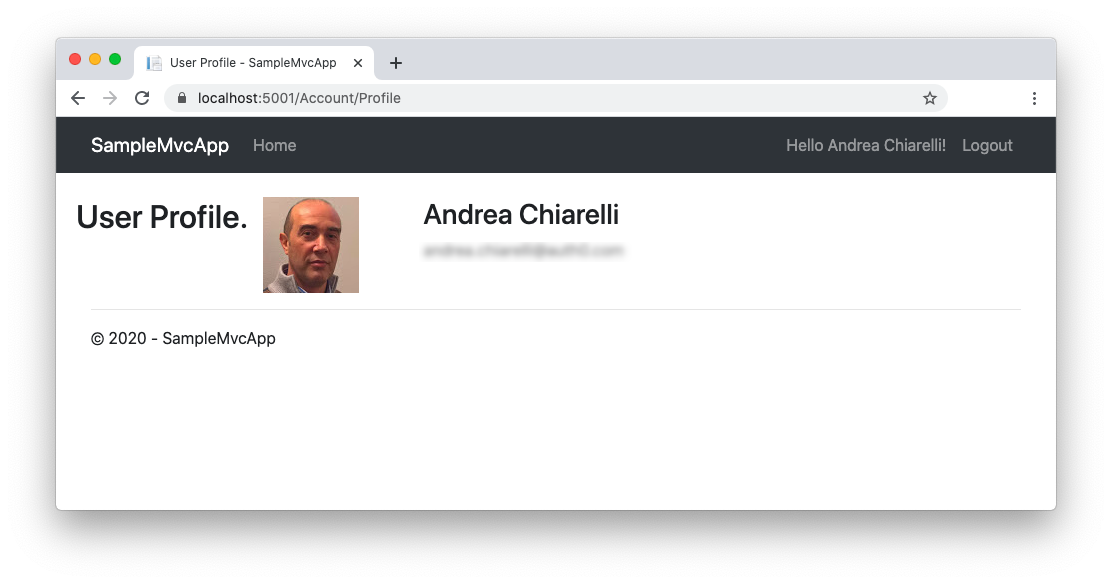C# extension methods let you easily add new functionality to existing classes. Learn how you can leverage them to simplify the Auth0 configuration for ASP.NET web apps.
ASP.NET Web Apps and Auth0
Adding Auth0 authentication to an ASP.NET web application is quite straightforward and doesn't require any specific Auth0 SDK. You can simply use the standard Microsoft.AspNetCore.Authentication.OpenIdConnect package to enable your web application to use the OpenID Connect (OIDC) protocol for user authentication. Let's take a look at how a typical ASP.NET web app configured with Auth0 looks like.
Getting the sample app
The sample application that comes with this article requires .NET Core 3.1 SDK, but you can easily adapt it to run with .NET 5 by simply changing the project's target framework.
As a first step, download the project from the starting-point branch of this GitHub repository. You can do it by running the following command in a terminal window:
git clone -b starting-point https://github.com/auth0-blog/auth0-dotnet-extension-methods.git
The project implements a basic ASP.NET MVC application that requires authentication to access the user's profile. It is the result of the Auth0 ASP.NET Core Quickstart.
Registering the web app with Auth0
To run your application, you need to register it with Auth0 and configure it with a few parameters. You can do this by accessing your Auth0 Dashboard and moving to the Applications section. If you don't have an Auth0 account yet, you can sign up for a free one right now.
Once you are in the Applications section, follow these steps to register your application with Auth0:
- Click the Create Application button.
- Provide a friendly name for your application (for example, Sample ASP.NET MVC App) and select Regular Web Application as the application type.
- Finally, click the Create button.
After you create the application, move to the Settings tab and take note of your Auth0 Domain, Client ID, and Client Secret. You will need these values to configure your application and allow it to communicate with Auth0.
Then, assign the value
https://localhost:5001/callbackhttps://localhost:5001/Finally, click the Save Changes button to apply them.
Configuring the web app
After registering your application with Auth0, you need to configure it with a few parameters from the Dashboard. So head to the root folder of your ASP.NET project and open the
appsettings.json{ "Logging": { "LogLevel": { "Default": "Information", "Microsoft": "Warning", "Microsoft.Hosting.Lifetime": "Information" } }, "AllowedHosts": "*", "Auth0": { "Domain": "{DOMAIN}", "ClientId": "{CLIENT_ID}", "ClientSecret": "{CLIENT_SECRET}" } }
Replace the
{DOMAIN}{CLIENT_ID}{CLIENT_SECRET}Consider the client secret to be the password of your application. Take care of it, and don't spread it around. Here, you are storing the client secret in the
file because the sample application is meant to run on the server, and users have no access to it.appsettings.json
Running your app
At this point, you should be able to launch the sample application by running this command:
dotnet run
In a few seconds, the application will start. You can access it by pointing your browser to the https://localhost:5001 address. You will see the following page in your browser:
If you click the Login link on the upper right corner of the page, you will be redirected to the Auth0 Universal Login page to authenticate:
Once you authenticate, you will see a new link in the header that allows you to see your own profile:
A look at the code
As said before, the integration between the ASP.NET MVC application and Auth0 relies on the Microsoft.AspNetCore.Authentication.OpenIdConnect package. You can see how it is used and configured by opening the
Startup.csConfigureServices()// Startup.cs // ...other code... public void ConfigureServices(IServiceCollection services) { services.AddAuthentication(options => { options.DefaultAuthenticateScheme = CookieAuthenticationDefaults.AuthenticationScheme; options.DefaultSignInScheme = CookieAuthenticationDefaults.AuthenticationScheme; options.DefaultChallengeScheme = CookieAuthenticationDefaults.AuthenticationScheme; }).AddCookie() .AddOpenIdConnect("Auth0", options => { options.Authority = $"https://{Configuration["Auth0:Domain"]}"; options.ClientId = Configuration["Auth0:ClientId"]; options.ClientSecret = Configuration["Auth0:ClientSecret"]; options.ResponseType = OpenIdConnectResponseType.Code; options.Scope.Clear(); options.Scope.Add("openid"); options.Scope.Add("profile"); options.Scope.Add("email"); options.CallbackPath = new PathString("/callback"); options.ClaimsIssuer = "Auth0"; options.SaveTokens = true; options.TokenValidationParameters = new TokenValidationParameters { NameClaimType = "name" }; options.Events = new OpenIdConnectEvents { OnRedirectToIdentityProviderForSignOut = (context) => { var logoutUri = $"https://{Configuration["Auth0:Domain"]}/v2/logout?client_id={Configuration["Auth0:ClientId"]}"; var postLogoutUri = context.Properties.RedirectUri; if (!string.IsNullOrEmpty(postLogoutUri)) { if (postLogoutUri.StartsWith("/")) { var request = context.Request; postLogoutUri = request.Scheme + "://" + request.Host + request.PathBase + postLogoutUri; } logoutUri += $"&returnTo={ Uri.EscapeDataString(postLogoutUri)}"; } context.Response.Redirect(logoutUri); context.HandleResponse(); return Task.CompletedTask; } }; }); services.AddControllersWithViews(); } // ...other code...
The
AddOpenIdConnect()Most of those settings are constant values in the Auth0 configuration generic case. Also, the verbose configuration code in the
ConfigureServices()Is there any way to simplify this approach in the Auth0 configuration?
By using C# extension methods, you can achieve this goal in a simple and elegant way.
You will not delve into this application's code and how it has been implemented. If you like to learn more about how this sample application has been built, please check out the Auth0 ASP.NET Quickstart.
What are C# Extension Methods?
An extension method is a C# feature that allows you to add a method to an existing type without creating a new derived type or modifying the original type. It is a static method, but you can invoke it as if it were a method of the original type.
Let's take a closer look at how extension methods work with an example. Suppose you want to extend the
System.StringVowelsCount()using System; using System.Linq; namespace MyExtensionMethods { public static class StringExtensions { public static int VowelsCount(this String inputString) { return inputString.Count(c => "aeiou".Contains(Char.ToLower(c))); } } }
The method of the
StringExtensionthisinputStringStringThis implementation allows you to call the
VowelsCount()string sentence = "This is a sample sentence."; Console.WriteLine(sentence.VowelsCount());
Extension methods are awesome and easy to implement. They are especially useful when you need to extend a class whose source code is not under your control. However, there are a few caveats to keep in mind. If the original class definition changes and gets a new method with the same signature as your extension method, your extension method will not be called. So use them wisely.
Auth0 Authentication as an Extension Method
Let's leverage the C# extension methods feature to simplify the typical configuration for Auth0 in an ASP.NET MVC application.
As a first step, create a new
AuthenticationAuth0Defaults.cs//Authentication/Auth0Defaults.cs using Microsoft.AspNetCore.Http; namespace Auth0.NET.Authentication { public class Auth0Defaults { public const string AuthenticationScheme = "Auth0"; public const string ClaimsIssuer = "Auth0"; public static readonly string CallbackPath = new PathString("/callback"); } }
This class simply defines a few constants that you will use in a minute.
In the same folder, create another file named
Auth0Options.cs//Authentication/Auth0Options.cs using Microsoft.AspNetCore.Authentication.OpenIdConnect; using Microsoft.IdentityModel.Protocols.OpenIdConnect; using Microsoft.IdentityModel.Tokens; namespace Auth0.NET.Authentication { public class Auth0Options : OpenIdConnectOptions { public string Domain { get; set; } public Auth0Options() { ResponseType = OpenIdConnectResponseType.Code; Scope.Clear(); Scope.Add("openid"); Scope.Add("profile"); Scope.Add("email"); CallbackPath = Auth0Defaults.CallbackPath; ClaimsIssuer = Auth0Defaults.ClaimsIssuer; SaveTokens = true; TokenValidationParameters = new TokenValidationParameters { NameClaimType = "name" }; } } }
The
Auth0OptionsOpenIdConnectOptionsFinally, let's create the
Auth0Extensions.cs//Authentication/Auth0Extensions.cs using System; using System.Threading.Tasks; using Microsoft.AspNetCore.Authentication; using Microsoft.AspNetCore.Authentication.OpenIdConnect; using Microsoft.Extensions.DependencyInjection; namespace Auth0.NET.Authentication { public static class Auth0Extensions { public static AuthenticationBuilder AddAuth0(this AuthenticationBuilder builder, Action<Auth0Options> configureOptions) { return builder.AddAuth0(Auth0Defaults.AuthenticationScheme, configureOptions); } public static AuthenticationBuilder AddAuth0(this AuthenticationBuilder builder, string authenticationScheme, Action<Auth0Options> configureOptions) { var auth0Options = new Auth0Options(); configureOptions(auth0Options); return builder.AddOpenIdConnect(authenticationScheme, options => { options.Authority = $"https://{auth0Options.Domain}"; options.ClientId = auth0Options.ClientId; options.ClientSecret = auth0Options.ClientSecret; options.ResponseType = auth0Options.ResponseType; options.Scope.Clear(); foreach(var scope in auth0Options.Scope) { options.Scope.Add(scope); } options.CallbackPath = auth0Options.CallbackPath; options.ClaimsIssuer = auth0Options.ClaimsIssuer; options.SaveTokens = auth0Options.SaveTokens; options.TokenValidationParameters = auth0Options.TokenValidationParameters; options.Events = new OpenIdConnectEvents { OnRedirectToIdentityProviderForSignOut = (context) => { var logoutUri = $"{options.Authority}/v2/logout?client_id={options.ClientId}"; var postLogoutUri = context.Properties.RedirectUri; if (!string.IsNullOrEmpty(postLogoutUri)) { if (postLogoutUri.StartsWith("/")) { var request = context.Request; postLogoutUri = request.Scheme + "://" + request.Host + request.PathBase + postLogoutUri; } logoutUri += $"&returnTo={ Uri.EscapeDataString(postLogoutUri)}"; } context.Response.Redirect(logoutUri); context.HandleResponse(); return Task.CompletedTask; } }; }); } } }
The
AddAuth0()AuthenticationBuilderAddAuth0()Auth0ConfigureServices()However, consider the first two statements of the
AddAuth0()//Authentication/Auth0Extensions.cs //...other code... public static AuthenticationBuilder AddAuth0(this AuthenticationBuilder builder, string authenticationScheme, Action<Auth0Options> configureOptions) { var auth0Options = new Auth0Options(); configureOptions(auth0Options); return builder.AddOpenIdConnect(authenticationScheme, options => { //...other code... } } //...other code...
The first statement creates an instance of the
Auth0OptionsconfigureOption()“A C# extension method adds a method to an existing type without creating a new derived type or modifying the original type.”
Tweet This
Using the Auth0 Extension Method
Let's take a look at how you can use the
AddAuth0()Startup.csConfigureServices()// Startup.cs // ...existing using... using Auth0.NET.Authentication; //👈 new addition // ...existing code... public void ConfigureServices(IServiceCollection services) { services.AddAuthentication(options => { options.DefaultAuthenticateScheme = CookieAuthenticationDefaults.AuthenticationScheme; options.DefaultSignInScheme = CookieAuthenticationDefaults.AuthenticationScheme; options.DefaultChallengeScheme = CookieAuthenticationDefaults.AuthenticationScheme; }).AddCookie() //👇 changed code .AddAuth0(options => { options.Domain = Configuration["Auth0:Domain"]; options.ClientId = Configuration["Auth0:ClientId"]; options.ClientSecret = Configuration["Auth0:ClientSecret"]; }); //👆 changed code services.AddControllersWithViews(); } // ...other code...
You added a reference to the
Auth0.NET.AuthenticationAddAuth0()appsettings.jsonThis simplifies Auth0 integration in the basic cases and makes the
ConfigureServices()You still have the capability of providing more advanced configurations. For example, if you want to specify a different callback page, you can do it as follows:
// Startup.cs // ...existing code... public void ConfigureServices(IServiceCollection services) { services.AddAuthentication(options => { options.DefaultAuthenticateScheme = CookieAuthenticationDefaults.AuthenticationScheme; options.DefaultSignInScheme = CookieAuthenticationDefaults.AuthenticationScheme; options.DefaultChallengeScheme = CookieAuthenticationDefaults.AuthenticationScheme; }).AddCookie() .AddAuth0(options => { options.Domain = Configuration["Auth0:Domain"]; options.ClientId = Configuration["Auth0:ClientId"]; options.ClientSecret = Configuration["Auth0:ClientSecret"]; //👇 new addition options.CallbackPath = new PathString("/callback-page"); }); services.AddControllersWithViews(); } // ...other code...
You now have a simple way to configure Auth0 in your ASP.NET web applications.
Summary
You started this article by exploring how to configure Auth0 by using the standard Microsoft.AspNetCore.Authentication.OpenIdConnect package in the
ConfigureServices()StartupConfigureServices()After you learned what C# extension methods are and how they work, you implemented the
AddAuth0()AuthenticationBuilderConfigureServices()You can find the final version of the sample project in this GitHub repository.
About the author

Andrea Chiarelli
Principal Developer Advocate
I have over 20 years of experience as a software engineer and technical author. Throughout my career, I've used several programming languages and technologies for the projects I was involved in, ranging from C# to JavaScript, ASP.NET to Node.js, Angular to React, SOAP to REST APIs, etc.
In the last few years, I've been focusing on simplifying the developer experience with Identity and related topics, especially in the .NET ecosystem.



